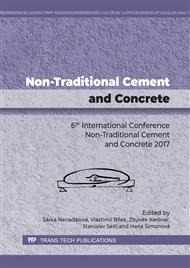[1]
A. Bentur, S. Mindess, Fibre reinforced cementitious composites, Modern Concrete Technology Series, CRC Press, Taylor & Francis Group, (2007).
Google Scholar
[2]
C.D. Johnston, Fibre-Reinforced Cements and Concretes, Taylor and Francis, (2010).
Google Scholar
[3]
B. Mobasher, Mechanics of Fibre and Textile Reinforced Cement Composites, CRC Press, Taylor & Francis Group, (2011).
Google Scholar
[4]
Tschegg E., Schneemayer A., Merta I., Rieder K.A. (2015).
Google Scholar
[5]
Tschegg E., Schneemayer A., Merta I., Rieder K.A. (2015).
Google Scholar
[6]
P. Ranalli, Agronomical and physiological advances in hemp crops, in: P. Ranalli (Ed. ), Advances in hemp research, The Haworth Press, New York, 1999, p.61–84.
DOI: 10.1201/9781498705820-11
Google Scholar
[7]
J. Müssig, Industrial applications of natural fibres: structure, properties and technical applications (Wiley series in renewable resource), John Wiley & Sons, West Sussex (United Kingdom, (2010).
Google Scholar
[8]
S. Rana, S. Pichandi, S. Parveen, R. Fangueiro, Natural Plant Fibres: Production, Processing, Properties and their Sustainability Parameters, in: S.S. Muthu (Ed. ), Roadmap to Sustainable Textiles and clothing, Textile Science and Clothing Technology, 2014, pp.1-35.
DOI: 10.1007/978-981-287-065-0_1
Google Scholar
[9]
L. Yan, B. Kasal, L. Huang, A review of recent research on the use of cellulosic fibres, their fibre fabric reinforced cementitious, geo-polymer and polymer composites in civil engineering, Composites Part B 92 (2016) 94-132.
DOI: 10.1016/j.compositesb.2016.02.002
Google Scholar
[10]
Swamy, R.N., (1990).
Google Scholar
[11]
J.H. Savastano, P.G. Warden, R.S.P. Coutts, Brazilian waste fibres as reinforcement for cement-based composites, Cem. Concr. Compos. 22 (2000), 379–384.
DOI: 10.1016/s0958-9465(00)00034-2
Google Scholar
[12]
Tolêdo Filho R D; Ghavami K; England G L; Scrivener K (2003). Development of vegetable fibre-mortar composites of improved durability. Cement & Concrete Composites, Volume 25, 185–196.
DOI: 10.1016/s0958-9465(02)00018-5
Google Scholar
[13]
Silva FA, Tolêdo Filho RD, Melo Filho JA, Rego Fairbairn E.M. (2010a) Physical and mechanical properties of durable sisal fibre–cement composites. Constr Build Mater; Volume 24(5): 777–85.
DOI: 10.1016/j.conbuildmat.2009.10.030
Google Scholar
[14]
Silva FA., Mobasher B, Tolêdo Filho RD. (2010b) Fatigue behavior of sisal fibre reinforced cement composites. Mat Sci Eng: A; Volume 527(21–22): 5507–13.
DOI: 10.1016/j.msea.2010.05.007
Google Scholar
[15]
Torgal F.P., Jalali S (2011), Fibrous and Composite Materials for Civil Engineering Applications Natural fibre reinforced concrete, University of Minho, Portugal, edited by R Fangueiro, Woodhead Publishing Limited ISBN: 978-1-84569-558-3.
DOI: 10.1533/9780857095583.2.154
Google Scholar
[16]
Merta I. (2016) Hemp Fibres—A Promising Reinforcement for Cementitious Materials. In: Fangueiro R., Rana S. (eds) Natural Fibres: Advances in Science and Technology Towards Industrial Applications. RILEM Bookseries, vol 12. Springer, Dordrecht.
DOI: 10.1007/978-94-017-7515-1_22
Google Scholar
[17]
J. Turk, Z. Cotič, A. Mladenovič, A., Šajna, Environmental evaluation of green concretes versus conventional concrete by means of LCA, Waste Management 45 (2015) 194-205.
DOI: 10.1016/j.wasman.2015.06.035
Google Scholar
[18]
Information on http: /gabi-documentation-2017. gabi-software. com/xml-data/processes/c3281353-27a8-44db-be8a-66a9834d4701. xml.
Google Scholar
[19]
Information on http: /gabi-documentation-2017. gabi-software. com/xml-data/processes/3fbc0b5f-1455-403a-9f7b-f624ebc2c912. xml.
Google Scholar
[20]
P. Gašparič, Z. Urisk, A. Križanec, M. Munda, S. Hribernik, M. Kurečič, T. Kreže, M. S Smole, Naravno obnovljiva rastlinska tekstilna vlakna, Tekstilec 55/4 (2012) 302-313.
Google Scholar
[21]
Information on http: /gabi-documentation-2017. gabi-software. com/xml-data/processes/db00901a-338f-11dd-bd11-0800200c9a66. xml.
Google Scholar
[22]
Merta I., A. Sajna, B. Poletanovic, A. Mladenovic, Influence of natural fibres on mechanical properties and durability of cementitious mortars. Construction materials for sustainable future, 1st international conference, 19-21 April 2017, Zadar, Croatia.
Google Scholar


